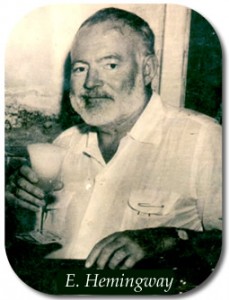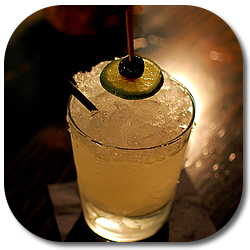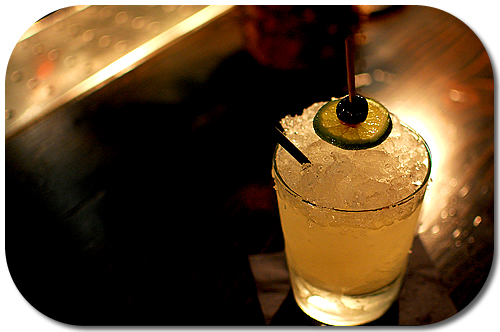Hemingway Daiquiri
2 oz White Rum
.75 oz Lime Juice
1 tsp Maraschino
1 tsp Grapefruit Juice
1 tsp Sugar or .5 oz Simple Syrup
Shake with ice and strain into a chilled cocktail glass. Serve frappe. (Download)
Daiquiris, Daiquiris everywhere and oh so many to drink. These days there are more Daiquiri “variations” than you can shake a Japanese Barspoon at, with everything from strawberries to thyme to bacon in them. Perhaps the most famous and somewhat hazy variant is the one named for author and Olympian drinker Ernest Hemingway: The Hemingway Daiquiri.
If the Daiquiri is the Holy Grail of rum mixology, the Hemingway Daiquiri may be the Lost Ark. Everyone claims to know what it is, but the actual history around it is somewhat nebulous.
The cocktail above is what you’ll commonly receive if you order a Hemingway Daiquiri. It is essentially La Florida Bartender Constante Grande’s Daiquiri #3. The 1935 edition of the La Florida Cocktail Book instructs the maker to serve the drink frappe, meaning that the cocktail glass should be filled with crushed ice. This is actually still very common with Daiquiri service in Cuba and Spain today – and it’s ridiculously good.
Now, looking at this you may ask, What, exactly, is so nebulous about the Hemingway Daiquiri?
The nebulous part is that nowhere in the Big Constante’s bar guides does he ever refer to a drink as the “Hemingway Daiquiri.”
 The recipe above was used for quite some time as La Florida’s house Daiquiri. This has led several to claim that this recipe is not the Hemingway Daiquiri, but rather the Floridita Daiquiri – another “famous” Daiquiri variant that is never mentioned in Constante’s work.
The recipe above was used for quite some time as La Florida’s house Daiquiri. This has led several to claim that this recipe is not the Hemingway Daiquiri, but rather the Floridita Daiquiri – another “famous” Daiquiri variant that is never mentioned in Constante’s work.
The evidence against the recipe being the Floridita (a diminutive, “nick-name” version of Florida, often used by locals when referring to La Florida), is somewhat circumstantial, but sufficient for me – and near as I can tell, for Ted Haigh, aka Doctor Cocktail. In Ted’s opus, Vintage Spirits and Forgotten Cocktails, he lists the recipe for the Floridita Daiquiri as matching what Constante referred to as Daiquiri #4, which is essentially the same as the recipe above, minus the grapefruit juice.
By their 1939 edition [of the La Florida Cocktail Cocktail Book], Constante…listed five daiquiris, #3 [was] the grapefruit variety. Two pages beyond the daiquiri recipes is a cocktail titled the “E. Henmingway [sic] Special.” It was the grapefruit recipe, blended.
This makes sense to me, especially since in the 1935 edition of Constantino’s guide, the Daiquiri #4 is subtitled “Florida Style.” Plus, who am I to argue with Doctor Cocktail? He’s got “Doctor” in his title!
Regardless of which recipe was the Floridita Daiquiri, the Hemingway Daiquiri still has plenty of history to it. Wayne Curtis outlines the connection between Papa Hemingway and Constante’s creation in his work, And a Bottle of Rum:
As [Constante] presided over his bar one day, a scruff, bearish man entered and asked to use the toilet. According to one account, when the man emerged from the bathroom and saw the daiquiris lined up on the bar, his curiousity was piqued. He asked for a sip. “That’s good, but I prefer it without sugar and double rum,” the man said. Constantino mixed one up to those specifications, and the man declared it very good. He was, of course, Ernest Hemingway. This modified version of the daiquiri became known as the Papa Doble. A later variation also enjoyed by Hemingway included a splash of grapefruit juice and a dash of maraschino liqueur: The Hemingway Special.
Mr. Curtis actually brings up another interesting point. You’ll note that in the account, the Papa Doble is invented when Hemingway orders the house Daiquiri with double the rum and no sugar. While the topic of which Daiquiri that was is still hotly debated (and the subject of a whole ‘nother post), what is obvious is that the Papa Doble is not the same drink as the Hemingway Daiquiri.
- El Dorado 3 Year Old
- Brugal White
- Old New Orleans Crystal
- Tommy Bahama White Sand
This is an important point because all too often I see bartenders and mixologists use the terms Hemingway Daiquiri and Papa Doble interchangeably, as though they are two names for the same drink. This is not the case.
Whereas the Doble was the house Daiquiri with no sugar and twice as much rum, the modern Hemingway Daiquiri and even the 1939 Hemingway Special both have only 2 ounces of rum and both contain sugar. There’s no way that either can be considered the Papa Doble.
In terms of the actual Hemingway Daiquiri, if we take the E. Hemingway Special and use it as the actual recipe, we see that it should be blended instead of shaken and served frappe-style, and none of the recipes call for the drink to be served “up.” This goes against what you commonly find served today at most cocktail bars. Part of the reason for this is the distaste for blenders in classic cocktail bars and the desire to bring the public around to the idea that Daiquiris do not come from slushee machines.
Personally I think that the Hemingway Daiquiri, like the original Daiquiri, is good enough that you should drink it in the way that you like – whether that be up, frappe or blended to a smooth slush.
In the end, we’re left with deductions and little in the way of real detail. We know that Hemingway liked Daiquiris at La Florida. We know that the Papa Doble was the first Hemingway-inspired Daiquiri, and we know that Constante added an “E. Henmingway Special” to his bar guide in 1939 which seems to be the Daiquiri #3 recipe, but blended.
As Ted Haigh says in his book, “Those are the facts, and from there the story goes straight to Hell.”
Question of the Day:
Where do you stand on the Hemingway Daiquiri debate?



Comments on this entry are closed.
The Cocktail Lovers
Great article. The Daiquiri is currently one of our favourite drinks. We’re having great fun mixing it up a bit by adding freshly muddled fruit or a measure of spiced rum and vanilla. Thanks to your article we’re going to give the Hemingway a go. We’ll let you know what we think
Matt Browner Hamlin
Well I think you’ve convinced me that the Papa Doble and Hemingway Daiquiri are different cocktails. But I don’t like math, so can you update the post with a recipe for a Papa Doble?
Or to be less cheeky, is the “House Daiquiri” that Hemingway ordered a #3 that included maraschino and grapefruit? Or is it a #1? Or something else?
Matt Robold
Matt: Actually I had intended on posting this a long time ago but it was precisely the fact that I couldn’t identify the original house daiquiri that became the Papa Doble.
That being said, the research is ongoing and while I have no definites, I do believe based on information that Jeff Berry has shared with me that the Papa Doble was likely the #3 with 4 oz of rum and no sugar.
The rub though, is that same account that I quote from Wayne Curtis’ book would seem to hint that the Papa Doble had no grapefruit and possibly no maraschino. In other words, it’s very possibly that the original Doble was a Daiquiri #1. The problem with this possibility is that even with as much love as I have for rum, the idea of drinking it with just lime juice and nothing else doesn’t strike me as anything special at all. I’d like to believe that there was at least Maraschino in the tin.
That should get posted either tomorrow or Friday.
Brian
wow. I’ve wondered about this for a while – I was having trouble remembering the difference between the “Hemingway” and the “Floridita” – only remembering that one had grapefruit, and one had maraschino. But I could never sort it out and it seemed to randomly change depending on what bar I was at. Sometimes the drink had both. 😉
This makes a lot more sense, even if it’s cloudier than before 😉
Paul
Readers, be sure to click the (“Download”) link at the end of the recipe for the recipe set against a beautiful picture of the drink! Matt, maybe I haven’t been paying close attention and you’ve been doing this all along, but wow, excellent work!
AlchemistGeorge
This is from
an article by Eric Felton in the Wall St. Journal:
I agree with Eric that the Daiquiri #3 recipe is “surprisingly bland drink”, for that reason we don’t use that recipe.
Matt Robold
The recipe I’ve posted is the recipe from the bar guide, but honestly I prefer a little more grapefruit in the drink than a teaspoon – along the lines of about .25 oz to .3 oz. The grapefruit juice matters too. You want good, white grapefruit and not the pink garbage that you generally find if you can help it.
To each his own, I suppose. I know quite a few people that prefer the Floridita aka Daiquiri #4, which is damn good. I prefer the #3 though – especially frappe.
I haven’t played around with blending it a lot. It’s something I need to do more often I think.
AriannaLA (GrapeSmart)
This is the first time I’ve read your blog. Now I’m thirsty. All of these daiquiris sound delicious – especially in this heat! I’m craving ocean breezes; big, slow-spinning ceiling fans; long shadows underscored by drumbeats in the background – and rum. Thanks for nuthin, Matt!
Stefan
Hmmm, I seem to recall reading that Hemingway was a diabetic recently somewhere… Don’t know enough about the man to tell if that is fact or fiction but it might affect the sugar content of a drink with Hemingway in the name..
Matt Robold
Stefan:
Hemingway was indeed diabetic. The legend of Hemingway and the daiquiri has a story about him trying one of a line that Constante had setup for the afternoon service at La Florida and saying that it was good, but that he’d prefer it with no sugar and double the rum.
That drink is known today as the Papa Doble, which is actually a wholly different drink than the Hemingway Daiquiri. This daiquiri is taken from Constante’s own bar guide, in which he refers to this recipe as the “E. Henmingway [sic] Special.”
I’m actually in the middle of a research project to learn more about this recipe and its relationship to Papa Hemingway, but my suspicion is that this is the version of the daiquiri that La Florida sold to other patrons, while only the more “hard-core” were joining Hemingway in drinking his preferred Papa Dobles.
V
Love the Hemingway Daiquiri, and it’s delicate layering of flavors. Very refreshing and aromatic. All day, long!
FITZMO
I was under the impression the drink called for Maraschino Liquor not mere Maraschino.
Camper English
Thanks – this was just the info I was looking for.
Hotel Charlie
I don’t know how useful or helpful this is, but Hemingway refers several times to the double frozen daiquiris, made without sugar, at La Floridita in Havana (the Papa Doble you’re talking about here), in his posthumously-published “Islands in the Stream”. The following quotes are from the section of the novel title “Cuba”:
“He [Thomas Hudson, Hemingway’s self-referential protagonist] had drunk double frozen daiquiris, the great ones that Constante [Grande, though his last name is not used in the book] made, that had no taste of alcohol and felt, as you drank them, the way downhill glacier skiing feels running through powder snow and, after the sixth and eighth, felt like downhill glacier skiing feels when you are running unroped.”
“He was drinking another of the frozen daiquiris with no sugar in it and as he lifted it, heavy and the glass frost-rimmed, he looked at the clear part below the trapped top and it reminded him of the sea. The frappéd part of the drink was like the wake of a ship and the clear part was the way the water looked when the bow cut it when you were in shallow water over marl bottom. That was almost the exact color.”
A little later Thomas Hudson says:
“This frozen daiquiri, so well beaten as it is, looks like the sea where the wave falls away from the bow of a ship when she is doing thirty knots.”
Hudson drinks at least 11 of these double frozens in one sitting by my count (he later estimates he had “about a dozen”), and that’s after starting the day with a whiskey while shaving and a Tom Collins while driving into town – not bad for a day’s work.
By the way, this is a great book for lovers of Hemingway and cocktails. The “Green Isaac’s Special” (also called a “Tomini” in the book), made with green coconut water, lime juice, gin and bitters, should really find its way onto the 320 Main menu … hint, hint.